As we enter the final 15 days of the campaign, there is clear evidence that the country’s economic recovery is slowing as the rate of coronavirus cases begins to increase again.
Trump and Republican candidates down-ballot head into the final two weeks of the campaign behind in the polls and at a severe financial disadvantage in races across the country.
Simply put, Democrats have raised an impressive amount of money this election cycle. In addition, early voting is at the highest rate in history and shows Democrats have the advantage. Senator Ben Sasse (R-NE) is the latest Republican to predict a dire outcome for the GOP, noting this past week, "we are staring down the barrel of a blue tsunami" as he publicly criticized Trump to his constituents this week.
However, Trump returned from quarantine to the campaign trail this week to headline at least one campaign event in a battleground state each day. This has provided significant earned media exposure in key markets, all while early voting continues and even undecided voters lock in their votes with just two weeks to go before the election.
Democrats and members of the media who predicted a Clinton victory in 2016 should not underestimate that Trump is the leader of a movement, not just a political campaign. And with that intensity of support, it is difficult to predict who will turn out to vote for him on Election Day.
This race is not over yet, as Biden Campaign Manager Jen O'Malley Dillon noted this week, "The very searing truth is that Donald Trump can still win this race, and every indication we have shows that this thing is going to come down to the wire.”
COVID-19
The amount of new coronavirus cases is at its highest level since July, and infectious disease experts warn of a substantial third wave of infections this winter. Ten states set single-day records for new cases on Friday.
There are now over 8,000,000 cases in the United States, with nearly 220,000 deaths.
In a new report in the Journal of the American Medical Association, per capita deaths from COVID-19 in the U.S. since May are at least 50% higher than any of the 18 highest income countries in the world.
According to Johns Hopkins University, there were over 69,000 new cases this past Friday, more than a 55% increase in just over a month.
In the last two weeks, 28 states plus the District of Columbia have experienced an increase of 25% or more of new cases, with new cases surging in the Midwest battleground states of Iowa, Michigan, Minnesota, Ohio, Pennsylvania, and Wisconsin.
The Economy
Most indicators reinforce the prevailing view that economic recovery has continued to cool down due to layoffs and an increase in coronavirus cases. There were 898,000 unemployment claims last week, the largest increase from the previous week in two months. Recently announced layoffs by several major U.S. corporations will contribute to higher numbers of Americans filing for unemployment compensation. There are also expectations of additional layoffs in the leisure and hospitality industries as we enter the winter months, due in part to the lack of a new federal aid package to stimulate the economy.
This is all occurring at a time in which laid off workers have not received a $600 federal unemployment supplement for almost three months. A Columbia University study released this week estimates that over eight million Americans have slipped into poverty since May.
Electoral College
All independent analyses currently project Biden well above the 270 electoral votes needed to win the White House. According to the most recent non-partisan 270 To Win map, Biden is currently leading in states with 290 electoral votes. Five states and two congressional districts totalling 85 electoral votes are still considered toss ups.
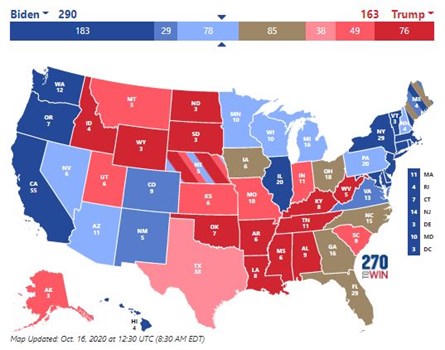
Battleground States
Biden continues to lead Trump in most of the battleground states, with a vote total near or above 50% in most of these states. Biden is not only winning most of the toss-up states that Trump carried in 2016, he is also leading or tied in states that were not close in 2016. Trump is now having difficulty in Iowa and Texas, states that he won by 9%, in Ohio where he won by 8%, in Georgia where he won by 5%, and in North Carolina where he won by 3.6%.
In addition, in almost all these states, Trump's percentage of the vote remains mired in the mid-40's. In 2016, it may have been enough for Trump to win with 46% of the vote in a five-person race. This will not be the case in 2020, when minor party candidates are a negligible factor and will receive far less than the 6% that these parties received in the last election.
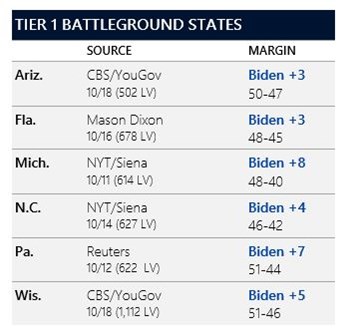
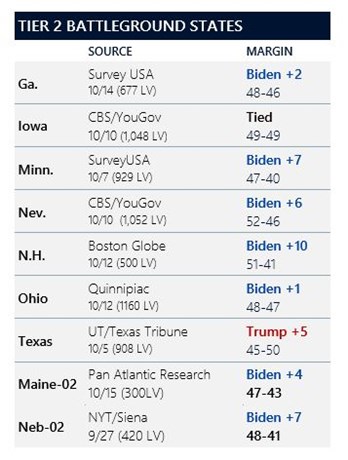
Voter Registration
There have been some positive indicators for the GOP in voter registration totals for the year.
In the four states that Trump won by less than 5% in 2016, where there is registration by party, voter registration trends have favored the Republicans. Since this year’s primaries, the GOP has registered almost 100,000 more voters than the Democrats in Florida, more than 77,000 new voters in Pennsylvania, and 45,000 in North Carolina. In Arizona, Republicans have registered nearly the same number of voters as Democrats.
In addition to registering new voters, there is tremendous potential for Trump to increase his vote totals in the Rust Belt states, if he can turn out previously registered voters who did not cast a ballot in 2016. There are huge chunks of these non-2016 voters in these three key rust belt states who fit the profile of a Trump supporter.
Election Day turnout remains an open question. In 2016, polling underestimated non-college white turnout in Michigan, Wisconsin, and Pennsylvania. Similar dynamics may be at play in 2020.
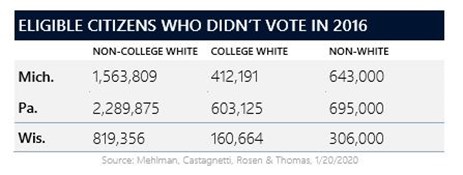
Fundraising
Fueled by anger towards Trump and Amy Coney Barrett’s nomination to the Supreme Court, Democrats have raised an unprecedented level of fundraising this election cycle. Biden and the DNC continue to raise a staggering amount of money, and now have a towering advantage in cash on hand over the Trump campaign and the RNC in the final days of the campaign.
By contrast, Trump and the RNC raised $458 million in the past 60 days, leaving them with a $289 million fundraising deficit in the same period.
These disparities in fundraising have had a significant impact on the amount of media purchased in battleground states. An NPR analysis of ad spending found that over $1 billion dollars has been spent on television ads this year. Biden and his allies have outspent Trump and the Republicans by $200 million during the campaign.
Almost 90% ($882 million) of this total has been bought in the Tier 1 battleground states of Arizona, Florida, Michigan, North Carolina, Pennsylvania, and Wisconsin, where Biden and the Democrats have outspent Trump and the Republicans by $240 million in these 6 states.
Biden entered October with $432 million cash on hand, compared to $251 million for Trump. In the past week Biden outspent Trump in 72 of the 83 media markets in key battleground states.
This tidal wave of money has also benefited Democrats up and down the ballot across the country. ActBlue, the Democratic Party's digital platform for raising money, reports that their candidates and left-leaning advocacy groups raised $1.5 billion in the last quarter, almost matching the $1.6 billion dollars raised during the entire 2018 election cycle. Half of that amount, $750 million, was raised in the 26 days following the death of Justice Ginsburg.
Early Voting
The predicted wave of Democrats in early voting has materialized, with record-setting early voting across the country. As of today, voters have cast over 27,732,584 ballots in 42 states, which is over six times the amount at this point in the 2016 election. In states with party registration, the data firm TargetSmart estimates that Democrats have cast 53% of the votes compared to only 36% by registered Republicans. However, polling suggests Republicans plan to vote on Election Day.
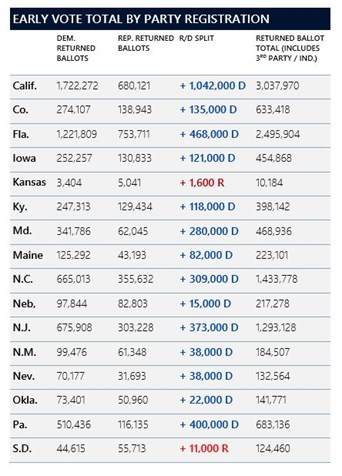
Counting the Votes
There has been a considerable amount of attention paid to the possibility that we will not know the outcome of the election until well past November 3rd. Under our system, each state has control over how elections are conducted. As a result, there is a great deal of variety across the country on how and when voting starts, the deadline for receiving ballots as well as when states can begin counting the votes.
Given the record-setting numbers of early voting in this year’s election, many states will be under considerable strain to process ballots in a timely fashion. There are three key battleground states, Michigan, Pennsylvania, and Wisconsin, where we can expect a delay of several days before all the votes are received and counted.
However, there are at least five Trump must-win states including Arizona, Florida, Iowa, North Carolina, and Ohio, that begin processing the early voting ballots long before Election Day. Unless the results from these states are extremely close, we should have a clear idea by 11 p.m. on election night who won these states.
If Trump were to lose any of these states, he would have an extremely difficult path to reaching the 270 electoral votes he needs for re-election.
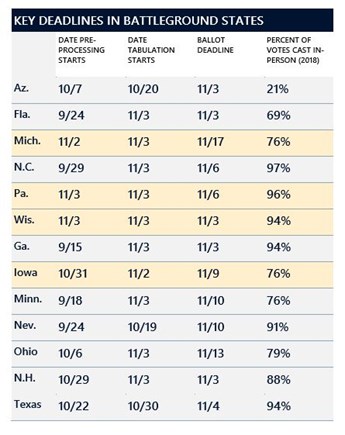
U.S. Senate
As Trump's political position continues to deteriorate nationally, Republicans’ chances of holding the Senate continue to diminish. In the most recent Cook Political Report, there are 12 Republican-held seats considered highly competitive. Democrats are favored to win the Republican-held seats in Colorado and Arizona, and are currently ahead in Maine, Iowa, and North Carolina. Democrats are also within the margin of error in recent polls in Montana, South Carolina, Kansas, Alaska, and both seats in Georgia.
The Cook Political Report only has two Democratic-held seats that are considered competitive.
The Republican challenger is favored to win the race in Alabama, while the Michigan Senate race leans towards the Democratic incumbent.
Democrats continue to have a financial advantage over Republicans. According to Open Secrets, through September, Democratic Senate candidates have raised $726 million dollars, compared to only $423 million dollars for the Republicans. Democrats enjoy an even larger cash on hand advantage going into the final days of the election.
According to Advertising Analytics, this election cycle has seven out of the 10 of the most expensive Senate races in history.
The House of Representatives
The Democrats remain heavily favored to hold the House, as it is unlikely that Republicans will be able to pick up the 17 seats necessary to regain the majority. The Cook Political Report currently projects Democrats to pick up a net of five to 15 seats.
Supreme Court
The Senate Judiciary Committee has scheduled a vote on the Barrett nomination for October 22nd at 1 p.m. A vote by the full Senate will likely be scheduled for the following week, a week before the election.
Debates
The final debate is scheduled for Thursday, October 22nd, at Belmont University in Nashville, Tennessee. The debate will be moderated by Kristen Welker of NBC News
Based on the trends in early voting, it is likely that one-third of the country will have voted prior to this debate.
What We Are Reading
POLITICO
Will flag-waving Latinos win Florida for Trump?
By Sabrina Rodriguez
The Washington Post
Trump aides seek to set aside division and plan for final sprint to Election Day
By Michael Scherer and Josh Dawsey
The Wall Street Journal
Trump Trails Among Seniors, Key Group in Many Battleground States
By Aaron Zitner and Dante Chinni
NPR
Biden Campaign Warns Supporters: 'Donald Trump Can Still Win This Race'
By Barbara Sprunt
The New York Times
Trump Runs the Kind of Campaign He Likes, but Not the One He Might Need
By Maggie Haberman and Alexander Burns
